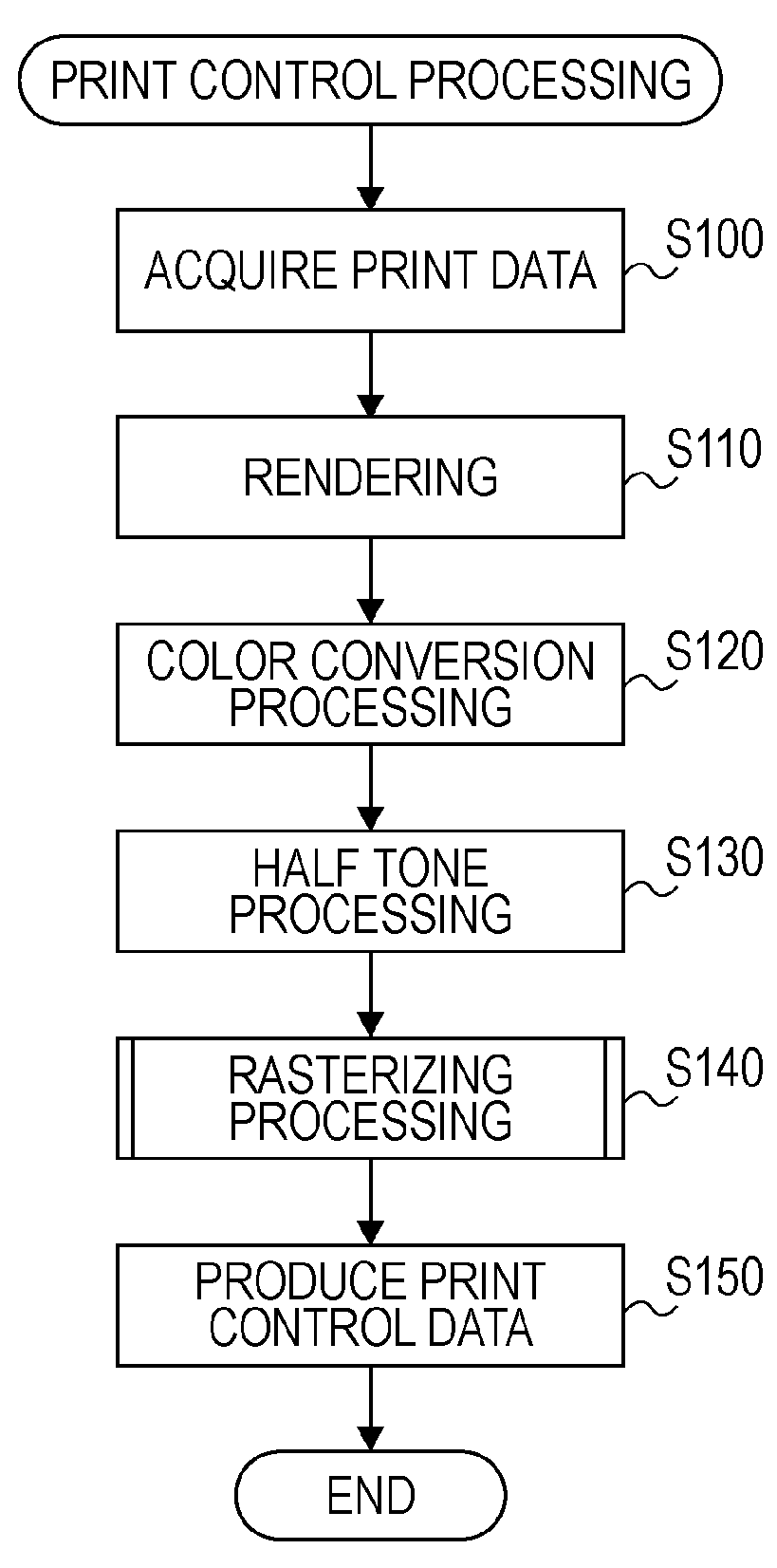[0006]An object of some aspects of the invention is that it provides a printer which is capable of effectively preventing brightness and concentration unevenness from occurring without lowering of printing speed. The object of some aspects of the invention is not limited to the provision of the printer which discharges ink but is also that it provides a general liquid ejection control device which
discharge liquid, a liquid ejection control method, and a liquid ejection control program. Accordingly, the invention is applied to a liquid ejection control device, a liquid ejection control method, and a liquid ejection control program.
[0009]Further, in an ejection nozzle group at a lead side of the ejection nozzle column which reaches the ejection object medium which is subordinately scanned first, it is possible to suppress the liquid amount placed on the ejection object medium for the first time by nonlinearly increasing the
ejection rate in each of primary scans in a manner such that the
ejection rate increases as it becomes nearer a rear side of the ejection nozzle column which lastly reaches the ejection object medium. On the other hand, in an ejection nozzle group at the rear side of the ejection nozzle column, the ejection rate nonlinearly decreases in each of primary scans as it becomes nearer the rear side. With this control, the ejection rate which is decreased in the ejection nozzle group at the lead side can be compensated by the ejection nozzle group at the rear side and therefore it is possible to prevent the ejection rate from becoming nonuniform.
[0010]In the ejection nozzle group at the lead side, when the ejection rate nonlinearly increased in each of primary scans as it becomes nearer the rear side, the increase amount may increase as it goes toward the rear side. With this control, it is possible to effectively suppress the ejection rate in the ejection nozzle group at the lead side. For example, by increasing the ejection rate in the ejection nozzle group at the lead side like a rising portion from a quadratic functional inflection point, it is possible to effectively suppress the ejection rate in the ejection nozzle group at the lead side. Further, the control may be performed such that the ejection rate is different according to the kind of liquid ejected from the ejection nozzles. Since the ejection characteristic is different according to the kind of liquid, it is preferable that the control of the ejection which is proper for the kind of liquid be performed.
[0011]Further, the control may be performed in a manner such that the ejection rate varies according to kind of liquid ejected from the ejection nozzles. Since the ejection characteristics are different according to kind of liquid, it is preferable that the control of the ejection which is proper for the kind of liquid be performed. In more detail, in the case in which liquid which needs a relatively longer fixing time when it is fixed on the ejection object medium in comparison with other liquids is ejected from the ejection nozzle column, of primary scans with respect to the primary
scan line at the same position in the subordinate scan direction, it is desirable that the ejection rate of the liquid in an initial primary scan be set higher than that of other liquids. Since it is possible to eject and fix the liquid, which needs a relatively longer fixing time, on the ejection object medium at a large amount at an initial stage, it is possible to suppress the problem, such as oozing and unevenness of ink. Typically, since there is tendency that the fixing time becomes longer as the concentration of the liquid becomes lower, the ejection rate in each of the primary scans at the initial stage may be adjusted according to the concentration.
[0012]In particular, in the case in which a pair of liquids containing the same mixture materials but having different concentrations of the mixture materials is ejected from the ejection nozzle column, the ejection rate of a liquid having a lower concentration of the pair of liquids in the initial primary scan of the primary scans with respect to the primary
scan line at the same position in the subordinate scan direction may be higher than that of the other liquid. With this control, it is possible to eject and fix the liquid, which needs the longer fixing time, on the ejection object medium at the large amounts at the initial stage. In the case in which a first liquid and a second liquid, of which the ejection amounts are larger than other liquids, are ejected from the ejection nozzle column, it is preferable that the ejection
control unit controls in a manner such that the ejection rate of the first liquid in the initial primary scan of the primary scans for the primary scan line at the same position in the subordinate scan direction be higher than that of the second liquid. Further, since the variations of the ejection rates of the first and second liquids are symmetric, it is possible to prevent both the ejection rates of the liquids from becoming higher in the initial and final primary scans of the primary scans. With this control, it is possible to reduce the total ejection amount in each of the primary scans with respect to the primary scan line, and to prevent the oozing and unevenness of liquid from occurring. Herein, the ejection rate means a rate of an area ejected in a predetermined area of using a first nozzle to the predetermined area, where a nozzle column including the first nozzle ejected.
 Login to View More
Login to View More  Login to View More
Login to View More 


